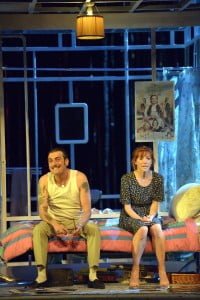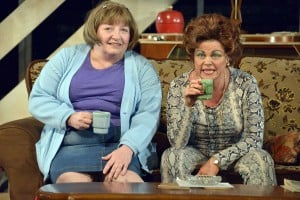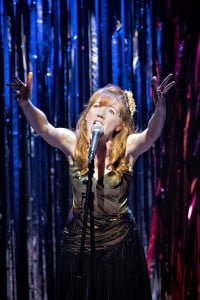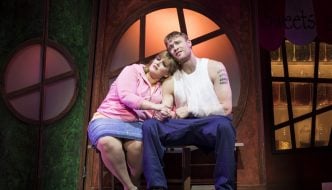‘There’s still love for a Little Voice’ – The Rise and Fall of Little Voice
June 15, 2015
[All images credited to Anthony Robling]
The Rise and Fall of Little Voice is a curious little play, one that’s been around for twenty years without really leaving British shores, perhaps due to its decidedly Northern setting and “is it a play / is it a musical?” ambivalence. Premiering in 1993, Little Voice was a hit with audiences, notable for its sly commentary on the grim early 90s’ political situation and its honest depiction of British working class life. It was also noteworthy for a striking central performance from Jane Horrocks, who shocked audiences with her incredible vocal impression abilities, the voices of Shirley Bassey and Judy Garland erupting from her quiet lips. But without the tense political climate and Jane Horrocks’s central turn, can Little Voice still make an impression on stage?
Little Voice follows a mother and daughter living a dead-end existence in a rundown Northern town. Mari, the mother, spends her life at the local clubs chasing men, while shy daughter LV hides herself in her bedroom, listening to her late father’s old records. “I’m all she has and she’s all I have,” says Mari, yet the two barely seem to know each other. When Mari’s new boyfriend Ray Say recognises LV’s singing abilities, he pushes her to aspire to bigger things.

If this sounds like an ugly-duckling turned singing-sensation crowdpleaser, it isn’t. It’s certainly a crowdpleaser, but for different reasons. Jim Cartwright’s script paints a perfect depiction of working-class life with sparky characterisation in Mari, who is arguably the star of the show. She’s a tragic, yet relatable, woman, simultaneously loving and neglectful of her virtuoso daughter.
The problem here is that the play hasn’t aged as well as the producers might have hoped. Its bum-tingling running time isn’t helped by a feather-light storyline, which even Cartwright’s wonderful dialogue can’t sustain. So little happens in the first act that, aside from some entertaining interactions between Mari and her best friend Sadie, it could almost be jettisoned. In addition, the character of LV is too cripplingly introverted to really root for as an unsung heroine. With modern understanding of learning disabilities, you worry for her in a way that the play might not have originally intended.

That’s not to say the production doesn’t deliver in other aspects. The standout here is the set, which designer Colin Richmond throws every ounce of creativity and authenticity into. It’s a breathtaking construction, a full-size house dominating the stage so that no detail of the characters’ lives goes unseen. The depth and detail of the set design is astonishing – “I’ve lived in that kitchen!” you might think – and this climaxes in a glorious display of theatrical wizardry.
The acting is also strong. Coronation Street’s Vicky Entwistle delivering a brassy performance that is overbearing and annoying, but for all the right reasons. As her overweight best friend Sadie, Joanna Brookes manages to mutely steal the show and provide much-needed heart, but appropriately it’s Nancy Sullivan who emerges the star, her LV combating even Jane Horrocks’s definitive portrayal. Her triumphant medley in the second act is a tour de force of vocal ability.

Director James Brining has successfully brought The Rise and Fall of Little Voice to modern audiences in the most powerful way it could be achieved, though it’s perhaps not a play for the ages. However, as the standing ovation can attest to, there’s definitely still some love for a Little Voice.
Joe Saxon
The Rise and Fall of Little Voice runs at the West Yorkshire Playhouse until 4th July. Don’t miss it!




Comments